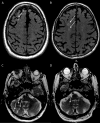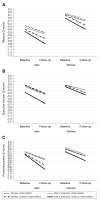Incidence of Brain Infarcts, Cognitive Change, and Risk of Dementia in the General Population: The AGES-Reykjavik Study (Age Gene/Environment Susceptibility-Reykjavik Study)
- PMID: 28765285
- PMCID: PMC5588878
- DOI: 10.1161/STROKEAHA.117.017357
Incidence of Brain Infarcts, Cognitive Change, and Risk of Dementia in the General Population: The AGES-Reykjavik Study (Age Gene/Environment Susceptibility-Reykjavik Study)
Abstract
Background and purpose: The differentiation of brain infarcts by region is important because their cause and clinical implications may differ. Information on the incidence of these lesions and association with cognition and dementia from longitudinal population studies is scarce. We investigated the incidence of infarcts in cortical, subcortical, cerebellar, and overall brain regions and how prevalent and incident infarcts associate with cognitive change and incident dementia.
Methods: Participants (n=2612, 41% men, mean age 74.6±4.8) underwent brain magnetic resonance imaging for the assessment of infarcts and cognitive testing at baseline and on average 5.2 years later. Incident dementia was assessed according to the international guidelines.
Results: Twenty-one percent of the study participants developed new infarcts. The risk of incident infarcts in men was higher than the risk in women (1.8; 95% confidence interval, 1.5-2.3). Persons with both incident and prevalent infarcts showed steeper cognitive decline and had almost double relative risk of incident dementia (1.7; 95% confidence interval, 1.3-2.2) compared with those without infarcts. Persons with new subcortical infarcts had the highest risk of incident dementia compared with those without infarcts (2.6; 95% confidence interval, 1.9-3.4).
Conclusions: Men are at greater risk of developing incident brain infarcts than women. Persons with incident brain infarcts decline faster in cognition and have an increased risk of dementia compared with those free of infarcts. Incident subcortical infarcts contribute more than cortical and cerebellar infarcts to incident dementia which may indicate that infarcts of small vessel disease origin contribute more to the development of dementia than infarcts of embolic origin in larger vessels.
Keywords: cognition; cohort studies; dementia; incidence; risk.
© 2017 American Heart Association, Inc.
Figures


References
-
- DeCarli C, Massaro J, Harvey D, Hald J, Tullberg M, Au R, et al. Measures of brain morphology and infarction in the framingham heart study: Establishing what is normal. Neurobiology of Aging. 2005;26:491–510. - PubMed
-
- Baune BT, Schmidt WP, Roesler A, Berger K. Functional consequences of subcortical white matter lesions and mri-defined brain infarct in an elderly general population. Journal of Geriatric Psychiatry and Neurology. 2009;22:266–273. - PubMed
-
- Vermeer SE, Koudstaal PJ, Oudkerk M, Hofman A, Breteler MMB. Prevalence and risk factors of silent brain infarcts in the population-based rotterdam scan study. Stroke. 2002;33:21–25. - PubMed
Publication types
MeSH terms
Grants and funding
LinkOut - more resources
Full Text Sources
Other Literature Sources
Medical

